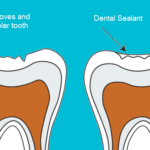Table of Contents
What are Dental Sealants?
Dental sealants are a preventive dental treatment that help protect teeth from decay. They consist of a thin, plastic material that is applied to the chewing surfaces of the back teeth. This material forms a protective barrier, sealing off the deep grooves and pits of the teeth where food particles and bacteria can accumulate. By preventing these areas from becoming trapped with debris, dental sealants reduce the risk of cavities and promote better oral health.
The process of applying dental sealants is quick and painless. First, the teeth are cleaned and dried thoroughly. Then, the sealant material is applied to the chewing surfaces of the teeth and allowed to bond and harden. Once in place, dental sealants can last for several years with proper care. They are most commonly recommended for children and teenagers who are at higher risk for developing tooth decay, but adults can also benefit from this preventive treatment. Overall, dental sealants are a valuable tool in maintaining optimal oral hygiene and preserving the health of teeth.

How Dental Sealants Work
Dental sealants are a protective coating that is applied to the chewing surfaces of back teeth. They act as a barrier, covering the pits and fissures where food particles and bacteria can easily get trapped. By sealing off these vulnerable areas, dental sealants help to prevent tooth decay and cavities.
The process of applying dental sealants is quick and painless. After cleaning and drying the teeth, a thin layer of a dental adhesive is applied. This adhesive allows the sealant material to bond securely to the tooth surface. Once the adhesive is in place, the sealant material is carefully painted onto the tooth, where it flows into the pits and fissures. A special curing light is then used to harden the sealant, creating a strong and durable protective layer. The result is a smooth and easy-to-clean surface that helps to keep teeth healthy and cavity-free.
Please note that this section does not include a conclusion.
The Importance of Dental Sealants
Dental sealants are a vital component of preventive oral care, particularly for children. These thin, protective coatings are typically applied to the chewing surfaces of the back teeth, where tooth decay is most likely to occur. By forming a barrier against harmful bacteria and acid, dental sealants help to safeguard the natural structure of the teeth.
The significance of dental sealants lies in their ability to significantly reduce the risk of cavities. According to the Centers for Disease Control and Prevention (CDC), sealants can lower the chance of decay in the protected teeth by nearly 80% for the first two years and continue to provide substantial protection for four years or more. Considering that dental caries (tooth decay) is the most common chronic disease among children, the importance of dental sealants in preventing the need for restorative treatments, such as fillings or crowns, cannot be overstated. Alongside a proper oral hygiene routine and regular dental check-ups, dental sealants offer a proactive approach to maintaining optimal oral health.

Who Should Get Dental Sealants?
Dental sealants are a preventive dental treatment that can benefit both children and adults. However, they are particularly recommended for children and teenagers who are more prone to cavities and dental decay. This is because the back teeth, also known as molars, have deep grooves and fissures that can easily trap food particles and bacteria, making them more susceptible to decay.
Children and teenagers who have not yet developed good oral hygiene habits or have difficulty reaching these difficult-to-clean areas may greatly benefit from dental sealants. According to studies, dental sealants can reduce the risk of cavities in these teeth by up to 80%. By providing a protective barrier over the chewing surfaces of the back teeth, sealants effectively prevent the accumulation of plaque and bacteria, thus reducing the risk of decay.
Additionally, individuals who have a history of dental cavities or who may have a higher risk of developing them, such as those with deep grooves or pits in their teeth, may also benefit from dental sealants. It is important to consult with a dentist to determine if dental sealants are a suitable option for you or your child, as they can provide personalized recommendations based on your oral health condition and risk factors.
| Age Group | Who Should Get Dental Sealants? |
|---|---|
| Children | – Children aged 6 to 14 years old, especially those prone to cavities |
| Adolescents | – Adolescents with newly erupted permanent molars |
| Adults | – Adults who are at high risk for tooth decay, particularly in hard-to-reach areas |
| Individuals with Specific Conditions | – Individuals with deep pits and fissures on their teeth, regardless of age |
| – Individuals with a history of cavities despite practicing good oral hygiene |
The Procedure for Applying Dental Sealants
Applying dental sealants is a simple and painless procedure that can be performed by a dentist or dental hygienist. The first step is to thoroughly clean and dry the teeth that will receive the sealant. This involves using a dental drill, toothbrush, and dental floss to remove any plaque, debris, or bacteria from the surface of the teeth.
Once the teeth are clean and dry, an etching gel is applied to the chewing surfaces of the teeth. This gel roughens the tooth surface, allowing the sealant to adhere more effectively. After the gel is applied, it is rinsed off and the teeth are dried again.
Next, the dental sealant is applied to the chewing surfaces of the teeth. The sealant is a thin, liquid resin that is painted onto the teeth and then hardened with a special light. This process usually takes only a few minutes per tooth.
After the sealant has been applied and hardened, it forms a protective barrier over the pits and grooves of the teeth. This barrier helps to prevent bacteria and food particles from getting trapped in these deep crevices where toothbrush bristles can’t reach. The result is a smoother, easier-to-clean tooth surface that is less prone to decay.
In conclusion, the procedure for applying dental sealants is a straightforward and painless process that can provide long-lasting protection against tooth decay. By sealing the pits and grooves of the teeth, dental sealants create a barrier that helps to keep teeth healthy and cavity-free.
Are Dental Sealants Painful?
Dental sealants are a safe and non-invasive procedure that is typically painless for patients. The process involves applying a thin, protective coating on the chewing surfaces of teeth to prevent tooth decay. The sealant material is usually composed of a clear or tooth-colored resin that bonds to the enamel of the teeth. It creates a barrier that seals off the deep grooves and pits, making it harder for plaque and bacteria to accumulate in these vulnerable areas.
During the application of dental sealants, there is no need for drilling or removing any tooth structure. The teeth are thoroughly cleaned and dried before the sealant is painted on. The material is then cured with a special light to harden it. Most patients report little to no discomfort during the procedure, as it is a quick and straightforward process.
In rare cases, some individuals may experience slight sensitivity or a tingling sensation immediately after the sealants are applied. However, this discomfort is usually temporary and subsides on its own. If any persistent or severe pain occurs, it is important to contact your dentist for further evaluation. Overall, dental sealants are a well-tolerated treatment option that can help protect teeth from cavities, especially in children and teenagers who may have difficulty maintaining optimal oral hygiene practices.

How Long Do Dental Sealants Last?
Dental sealants are a protective coating applied to the biting surfaces of the back molars to prevent dental decay. One of the questions frequently asked about dental sealants is how long they last. The longevity of dental sealants depends on various factors, including the quality of the sealant material used, the technique applied during the procedure, and the individual’s oral hygiene habits.
On average, dental sealants can last for several years, with some studies reporting up to 10 years of effectiveness. However, it is important to note that the lifespan of sealants can vary from person to person. Factors such as the amount of wear and tear the teeth are subjected to, the chewing habits of the individual, and the effectiveness of home dental care practices can influence the durability of sealants.
Regular dental check-ups are crucial to evaluate the condition of dental sealants and determine whether they need to be replaced. The dentist will examine the sealants during routine examinations, checking for any signs of wear or chipping. If necessary, they can be repaired or reapplied to ensure continued protection against dental decay.
It is essential to remember that dental sealants do not last a lifetime. Over time, they may wear down or chip away, leaving the tooth vulnerable to decay. Therefore, maintaining good oral hygiene practices, such as proper brushing and flossing, is still crucial even with the presence of dental sealants. By following a consistent dental care routine and attending regular dental check-ups, individuals can maximize the longevity and effectiveness of their dental sealants.
Benefits of Dental Sealants
Dental sealants offer numerous benefits for patients of all ages. By applying a thin, protective coating to the teeth, sealants effectively block out bacteria and food particles from reaching the vulnerable areas of the teeth. This, in turn, helps to prevent decay and cavities. According to a study published in the Journal of the American Dental Association, dental sealants can reduce the risk of cavities in permanent molars by a staggering 80%. Additionally, sealants can last for several years before requiring replacement, providing long-term protection for your teeth.
One of the main advantages of dental sealants is their ability to save both time and money in the long run. By acting as a barrier against harmful substances, sealants can significantly decrease the likelihood of needing costly dental procedures, such as fillings or root canals. Not only does this benefit patients financially, but it also promotes overall oral health by minimizing the need for invasive treatments. For children and teenagers especially, dental sealants can be particularly beneficial, as they offer extra protection during the years when tooth decay is most prevalent. By investing in dental sealants, patients can enjoy the peace of mind that comes with knowing their teeth are shielded from harmful bacteria and decay.
Potential Risks and Side Effects of Dental Sealants
Potential Risks and Side Effects of Dental Sealants
While dental sealants are considered safe and effective, it is important to be aware of potential risks and side effects. One possible risk is an allergic reaction to the materials used in the sealant, such as the resin or BPA (bisphenol A). Although rare, some individuals may experience an allergic response, which can include symptoms like itching, skin rashes, or swelling. It is crucial to inform your dentist about any known allergies before getting sealants applied.
Another potential side effect is the possibility of sealant degradation. Over time, sealants may wear down or develop small cracks, which can create an environment for bacteria to colonize. This can potentially lead to tooth decay if not properly addressed. It is essential to maintain regular dental visits for routine check-ups and have any deteriorating sealants repaired or replaced by a dental professional. Additionally, individuals who grind their teeth or have a misaligned bite may be more prone to sealant degradation and should be mindful of this possible risk.
While these risks and side effects are relatively uncommon, it is important to be informed and discuss any concerns with your dentist. They can provide personalized advice based on your dental health and determine if dental sealants are the right option for you or your child. By weighing the benefits and potential risks, you can make an informed decision and take necessary precautions to ensure your oral health remains in optimal condition.
| Potential Risks/Side Effects | Description |
|---|---|
| Tooth Sensitivity | Some individuals may experience tooth sensitivity after sealant placement, especially if the sealant is applied too close to the gum line or if there is an underlying dental issue. |
| Allergic Reactions | Rarely, individuals may have allergic reactions to the materials used in dental sealants, such as the resin or bonding agents. Symptoms may include swelling, itching, or redness in the mouth. |
| Bacterial Growth | Improperly placed or poorly maintained sealants can potentially trap bacteria beneath the sealant material, leading to decay and other dental problems. Regular dental check-ups are essential to monitor the condition of sealants. |
| Sealant Dislodgement | In some cases, sealants may become dislodged from the tooth surface, especially if they were not properly applied or if the individual engages in habits like teeth grinding or nail-biting. Dislodged sealants may require reapplication. |
| Incomplete Sealant Coverage | Sealants may not completely cover the pits and fissures of the tooth surface, leaving areas vulnerable to decay. Proper application techniques and thorough examination are necessary to ensure adequate coverage. |
| Bisphenol A (BPA) Exposure | Some dental sealants contain bisphenol A (BPA), a chemical that has raised concerns about potential health risks, especially in children. While the amount of BPA exposure from sealants is minimal, individuals with concerns should discuss alternative options with their dentist. |
Caring for Dental Sealants
Once dental sealants have been applied, it is important to take proper care of them to ensure their longevity and effectiveness. The good news is that caring for dental sealants is relatively simple.
First and foremost, it is crucial to maintain a consistent oral hygiene routine. This includes brushing your teeth at least twice a day with a fluoridated toothpaste and flossing daily. While dental sealants provide an extra layer of protection, it is still important to remove any plaque or food particles that may accumulate on the surface of your teeth. Regular dental check-ups and cleanings are also essential to monitor the condition of your sealants and address any potential issues promptly. Additionally, avoiding habits that can potentially damage the sealants, such as biting on hard objects or opening packages with your teeth, can help prolong their lifespan.
Cost of Dental Sealants
Dental sealants are a preventive dental treatment that helps to protect teeth from decay and cavities. When considering the cost of dental sealants, it’s important to recognize the long-term benefits they provide. While the initial expense may vary depending on several factors such as the number of teeth being treated, the average cost for a single tooth sealant ranges from $30 to $60.
Compared to the cost of treating a cavity or undergoing more extensive dental procedures, dental sealants are a cost-effective investment in oral health. Additionally, dental sealants can last for several years with proper care, reducing the need for additional treatments or interventions. Many dental insurance plans cover the cost of sealants, especially for children, as they are recognized as a preventative measure. However, it’s always prudent to check your specific dental insurance policy to verify coverage.
In conclusion, the cost of dental sealants may vary, but it’s important to consider the long-term benefits they offer. By providing a protective barrier against tooth decay, sealants can potentially save you from more extensive and costly dental procedures in the future. With the potential for insurance coverage and the lasting effects of sealants, it’s an investment worth considering for maintaining optimal oral health.
Are Dental Sealants Covered by Insurance?
Dental sealants are a preventive dental treatment that can help protect against tooth decay. One common question that arises when considering this treatment is whether dental sealants are covered by insurance. The coverage of dental sealants can vary depending on the individual insurance plan.
In many cases, dental insurance plans do cover the cost of dental sealants. This is because sealants are recognized as an effective preventive measure for maintaining oral health and preventing the need for more extensive and costly dental treatments in the future. However, it is important to note that not all insurance plans provide coverage for dental sealants. Some plans may cover sealants for certain age groups, such as children, while others may have specific limitations or restrictions. It is advisable to check with your insurance provider and review the details of your plan to determine if dental sealants are covered and what the specific terms of coverage may be.
Alternatives to Dental Sealants
While dental sealants are considered to be a highly effective preventive measure against tooth decay, there are alternative options available for individuals who may not be suitable candidates for sealant application. One alternative to dental sealants is fluoride treatment. Fluoride is a mineral that helps to strengthen tooth enamel and make it more resistant to acid attacks from bacteria and sugar. It can be applied as a gel, foam, or varnish during regular dental check-ups. Fluoride treatment is particularly beneficial for individuals who have a higher risk of developing tooth decay, such as those with a history of cavities or dental issues.
Another alternative to dental sealants is practicing thorough oral hygiene. This includes brushing your teeth twice a day with fluoride toothpaste, flossing daily, and using mouthwash to help control bacteria in the mouth. Additionally, maintaining a healthy diet and limiting the consumption of sugary and acidic foods and drinks can play a significant role in preventing tooth decay. Regular dental check-ups and cleanings are also essential for early detection of dental issues and for professional cleaning to remove plaque and tartar buildup. It is important to consult with a dentist to determine the most suitable preventive measures based on individual dental health needs.
What to Expect During a Dental Sealant Appointment
During a dental sealant appointment, you can expect a straightforward and painless procedure that typically takes around 30 minutes to an hour. The dental professional will begin by thoroughly cleaning and drying the surface of the teeth that will be sealed. This ensures that the sealant bonds effectively to the tooth enamel.
Next, a special gel or liquid will be applied to the teeth to create a rough surface. This allows the sealant to adhere better to the teeth. After the teeth are prepared, the dental professional will apply the sealant material onto the chewing surfaces of the molars and premolars. A dental curing light may be used to harden and set the sealant quickly.
It’s essential to note that the sealant material is clear or tooth-colored, making it virtually invisible once applied. This means that the appearance of your teeth will not be affected by the sealants. Furthermore, the process is quick, painless, and does not require any anesthesia, making it suitable for individuals of all ages.
Tips for Maintaining Oral Health with Dental Sealants
Maintaining good oral health is essential, especially after getting dental sealants. While sealants provide an added layer of protection for your teeth, it is still important to take proper care of them to ensure their longevity and effectiveness. Here are some tips to help you maintain oral health with dental sealants.
Firstly, make sure to practice good oral hygiene by brushing your teeth twice a day for two minutes each time. Choose a soft-bristled toothbrush and fluoride toothpaste to effectively remove any plaque build-up. Pay extra attention to the areas where the sealants are applied, ensuring thorough cleaning without applying excessive pressure.
In addition to regular brushing, don’t forget to floss daily. Dental floss can reach areas that a toothbrush may not be able to, such as between teeth and along the gumline. Gently guide the floss between your teeth, making sure to clean along the sides of the sealed teeth as well.
Furthermore, maintaining a healthy diet plays a significant role in oral health. Limit sugary and acidic foods and beverages, as they can lead to tooth decay and compromise the effectiveness of the sealants. Instead, opt for a diet rich in fruits, vegetables, whole grains, and lean proteins. These choices help promote overall oral health and prevent any potential damage to your teeth.
Lastly, regular dental check-ups are crucial to monitor the condition of your sealants and overall oral health. Your dentist will assess the sealants during your routine exams and cleanings, ensuring they are intact and functioning as intended. If any issues or deterioration are observed, your dentist can take appropriate action to address them early on.
By following these tips and incorporating them into your oral hygiene routine, you can help maintain the longevity and effectiveness of your dental sealants, providing ongoing protection for your teeth and preventing any potential dental problems. Remember, good oral health with sealants requires consistent and diligent care.
Frequently Asked Questions about Dental Sealants
FAQs about Dental Sealants
Q: How long does the dental sealant application procedure take?
A: The dental sealant application procedure is a quick and straightforward process. On average, it takes around 10 to 15 minutes per tooth. However, the exact time can vary depending on the number of teeth being sealed and the cooperation of the patient.
Q: Can adults get dental sealants?
A: Although dental sealants are more commonly associated with children, adults can also benefit from them. If an adult has deep grooves and pits on their teeth that are prone to decay, dental sealants can provide an extra layer of protection. Your dentist will evaluate your specific case to determine if dental sealants are a suitable option for you.
Q: Are dental sealants permanent?
A: While dental sealants are durable, they are not permanent. On average, dental sealants can last for several years before they naturally wear off or chip away. Regular dental check-ups are essential to monitor the condition of your sealants and determine if any repairs or reapplication are necessary.
Q: Are dental sealants covered by insurance?
A: Many dental insurance plans cover the cost of dental sealants, especially for children. However, coverage can vary, so it’s important to check with your insurance provider to determine the specifics of your plan. If dental sealants are not covered, it’s important to discuss with your dentist alternative options and potential costs.
Q: Do dental sealants require any special care?
A: Dental sealants do not require any special care or maintenance. However, it is crucial to maintain good oral hygiene practices, such as regular brushing, flossing, and rinsing with mouthwash. Additionally, it’s important to attend regular dental check-ups to ensure the sealants remain intact and effective.
Q: Can dental sealants be applied to baby teeth?
A: Yes, dental sealants can be applied to baby teeth. Baby teeth play a vital role in the development of permanent teeth, so protecting them from early decay is crucial. Dental sealants can help prevent cavities and maintain healthy baby teeth until they naturally fall out.
Q: How soon can I eat and drink after getting dental sealants?
A: Unlike certain dental procedures, there is no specific waiting period after getting dental sealants. As soon as the application is complete, you can resume your normal eating and drinking habits without any restrictions.
Q: Will dental sealants interfere with orthodontic treatment?
A: Dental sealants do not interfere with orthodontic treatment; in fact, they can provide an added layer of protection for teeth during the orthodontic process. Your orthodontist will work in conjunction with your dentist to ensure the sealants do not hinder the progress of your orthodontic treatment.
Q: Can I get dental sealants if I have existing cavities?
A: Dental sealants are designed to prevent cavities rather than treat existing ones. If you have cavities, it is essential to address them with appropriate dental treatment before considering the application of dental sealants.
Q: Is the process of applying dental sealants painful?
A: No, the process of applying dental sealants is not painful. It is a non-invasive procedure that only involves cleaning, drying, and applying the sealant material to the teeth. Most individuals experience no discomfort or pain during the process.
Q: Are dental sealants noticeable on the teeth?
A: Dental sealants are tooth-colored or clear, making them virtually unnoticeable on the teeth. They blend in with the natural tooth color, ensuring a seamless appearance while providing the necessary protection against cavities.
Q: Are dental sealants a substitute for brushing and flossing?
A: No, dental sealants are not a substitute for regular brushing and flossing. While sealants provide an extra layer of defense against tooth decay, maintaining good oral hygiene practices is still crucial to ensure overall dental health.
Q: Are there any known risks or side effects associated with dental sealants?
A: Dental sealants have been used for decades and are considered safe and effective. However, in rare cases, an individual may experience an allergic reaction to the sealant material. It is essential to inform your dentist about any known allergies or sensitivities before the procedure.
Q: How much do dental sealants cost?
A: The cost of dental sealants can vary depending on several factors, including the number of teeth being sealed and the location of the dental practice. On average, the cost per tooth can range from $30 to $60. Consulting with your dentist will provide a more accurate estimate based on your specific needs.
Q: How often should dental sealants be checked by a dentist?
A: Regular dental check-ups are crucial to monitor the condition of your dental sealants. Your dentist will assess the sealants during routine examinations and determine if any repairs or reapplication are necessary. Generally, dental sealants should be checked at least once a year.
Q: Can sealants be removed if necessary?
A: Yes, dental sealants can be removed if necessary. However, it is recommended to consult with your dentist before deciding to remove them, as they provide valuable protection against tooth decay. Your dentist will assess the situation and provide appropriate guidance based on your specific needs.
How do dental sealants work?
Dental sealants work by creating a protective barrier on the teeth, sealing off the deep grooves and pits where bacteria and food particles can accumulate. This helps prevent cavities and tooth decay.
Who can benefit from dental sealants?
Dental sealants are most commonly recommended for children and teenagers who have their permanent molars and premolars erupted. However, adults who are prone to cavities or have deep grooves on their teeth may also benefit from dental sealants.
Does getting dental sealants hurt?
Getting dental sealants is a painless procedure. The teeth are cleaned, dried, and then the sealant material is applied and hardened using a special light. Patients typically experience no discomfort during the process.
How long do dental sealants last?
Dental sealants can last for many years with proper care. On average, they can last anywhere from 5 to 10 years before they may need to be replaced. Regular dental check-ups can help monitor the condition of the sealants.
Are there any risks or side effects associated with dental sealants?
Dental sealants are considered very safe. However, in rare cases, some individuals may experience an allergic reaction to the materials used. It is important to discuss any concerns with your dentist before getting dental sealants.
How should I care for dental sealants?
Caring for dental sealants is easy. Brushing your teeth twice a day with a fluoride toothpaste and flossing daily is essential. Additionally, regular dental check-ups and professional cleanings will help ensure the sealants stay intact.
How much do dental sealants cost?
The cost of dental sealants can vary depending on various factors such as the number of teeth being sealed, the dentist’s location, and additional procedures. However, on average, the cost per tooth can range from $30 to $60.
Are dental sealants covered by insurance?
Many dental insurance plans cover the cost of dental sealants, especially for children. However, it is recommended to check with your insurance provider to determine the exact coverage and any limitations.
What are the alternatives to dental sealants?
Alternatives to dental sealants include maintaining good oral hygiene practices, such as regular brushing and flossing, and using fluoride toothpaste and mouthwash. However, these alternatives may not provide the same level of protection as dental sealants.
What can I expect during a dental sealant appointment?
During a dental sealant appointment, the dentist or dental hygienist will clean and dry your teeth. They will then apply the sealant material to the specific teeth being sealed and use a special light to harden it. The process is quick and painless.
Any tips for maintaining oral health with dental sealants?
To maintain oral health with dental sealants, it is important to continue practicing good oral hygiene. This includes brushing your teeth twice a day, flossing daily, and visiting your dentist regularly for check-ups and cleanings.











